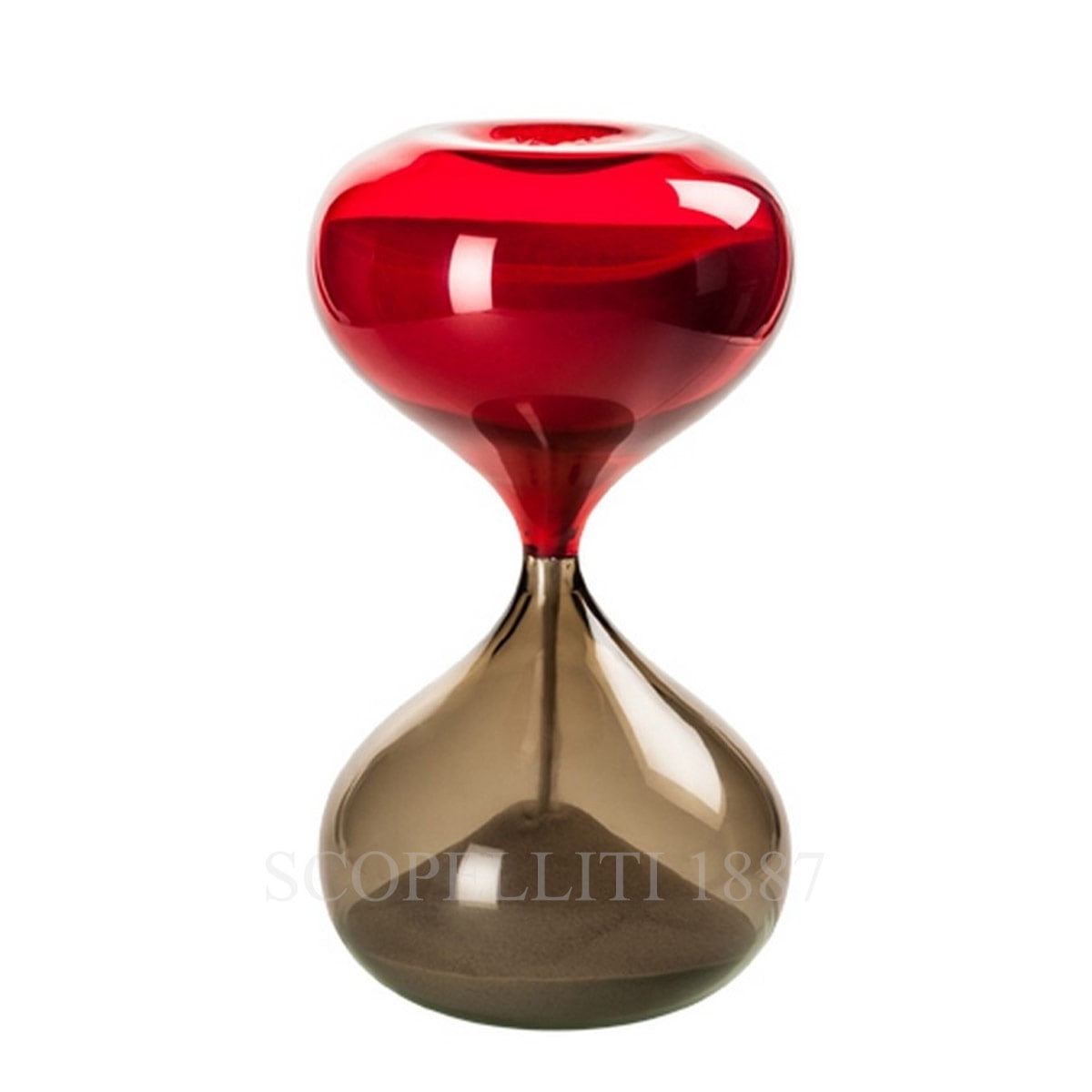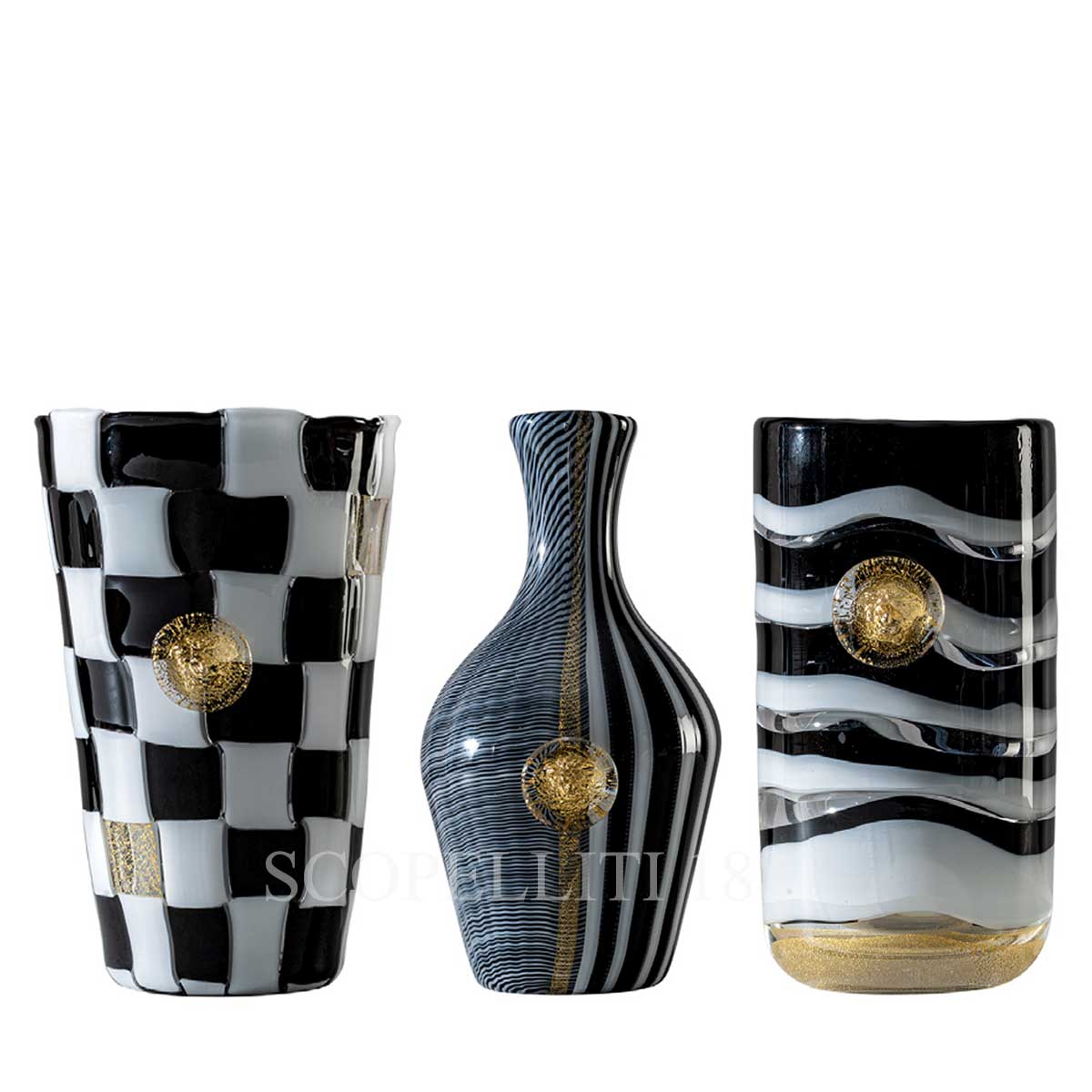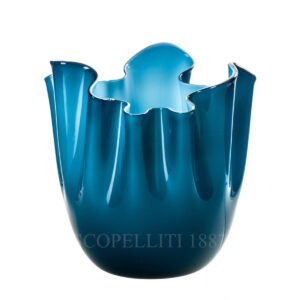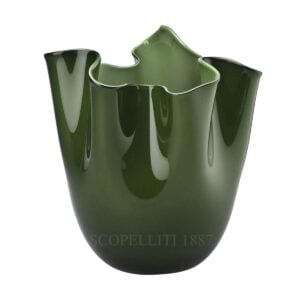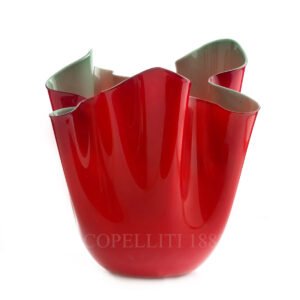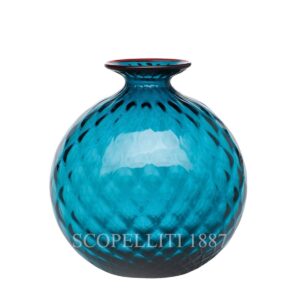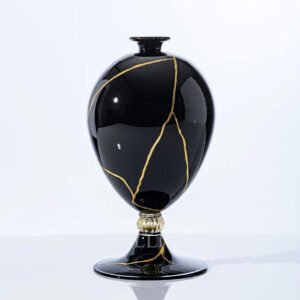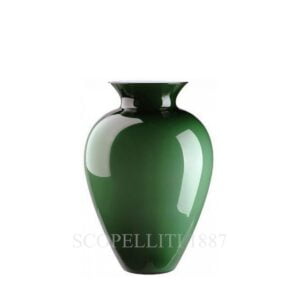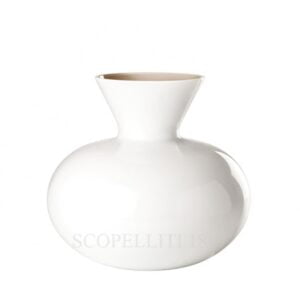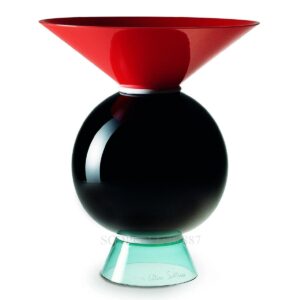
Venini Vases – Authorized Dealer
“Venini Vases are the glass turned into emotions, balance of the shapes, lines, colors and functions.”

Venini vases has charmed the lovers of glass art worlwide for more than hundred years. Venini vases stand out for their unique design, dominated by essential lines combining artisanal manufacturing techniques and innovation.
Art Glass
Discover the Whole Venini Art Glass collection!
Art Light
Discover a whole range of Venini chandeliers, table lamps and more.
Venini Vases New Colors 2023
Elegance has no excess, no frills, no illusions. Elegance is purity, it is essential and perfect lines. It is sophisticated color able to get noticed for delicacy. Elegance is a handmade blown glass vase, that never reveals her age and has been in exhibitions and publications worldwide for over eighty years. Venini Vases spring summer collection 2023 are create in magenta pink and paraiba transparent and opaline blown glass, glossy and matte.
Handkerchief Venini Vases
Venini vase Handkerchief (in italian: Fazzoletto) is an icon of Venini. For over 50 years it has been featured in museums and art exhibitions. Fazzoletto Venini vases, handmade and blown, each one is unique. Using a highly suggestive technique, the master glass blower gives the still soft glass the form of an upturned handkerchief.
Does it move with the wind? Will it move when I blow on it? Shall I try? Fazzoletto (‘Handkerchief’) is one of the first works designed by Fulvio Bianconi for Venini and is created by a master glassmith with a soft, but firm, sweeping gesture. A gesture that is art, magic, poetry and pride, as it has become part of the permanent exhibits at the MoMA in New York. View all colors and sizes of Fazzoletto Handkerchief Venini vases!
Monofiore Venini Vases
The coloured glass ring is a result of the so-called “Balloton” technique. In order to produce it, a glass thread is applied when hot on the top of the “Monofiori Balloton” Venini vases. This forms a pretty contrast to the round-shaped body of the Murano glass vase. View all colors and sizes of Monofiore Venini Vases!
Veronese Venini Vases
Veronese vase by Vittorio Zecchin, VENINI’s original artistic director. The imprint made by this artist on production definitely broke away from the dominant trends at that time, refusing the superfluous to find inspiration in the classic models of the 1400s and 1500s, like in this 1921 vase, based on the painting “Annunciation of the Virgin” by Paolo Veronese. The vase was an enormous success, so much so that it became the firm’s “logo”. View all colors!
Labuan Venini Vases
Venini Labuan vases are inspired by eastern culture. The East has always been a source of creative inspiration, so it influence this collection. Its formal purity is defined by its gentle curves. View all colors and sizes!
Idria Venini Vases
Venini vase Idria, a blown and hand-shaped opaline glass vase, reinterprets the ancient function of the vase as container. The soft shapes of the base meet the conical element that defines the height of the work, in a harmony of great balance. For more colors of Idria Venini Vases click here!
Opalino Venini Vases
Opalino is a vase designed by Venini. Venini’s Opalino vase has been featured in exhibitions and publications all over the world. These hand-blown and crafted glass vases produced in dozens of colors feature pure, essential lines. View all colors and sizes of Opalino Venini Vases!
Venini Hourglass Clessidre
“Clessidre” is a Venini collection of hourglass designed by Paolo Venini & Fulvio Bianconi. These hand blown hour glasses leave the sand inside trickle down slowly, as if in perpetual equilibrium between today and yesterday. Handmade and blown glass. The “Incalmo” technique it is employed in the thinner part of the object and it underlines the difficult hand-manufacturing.
Venini Masterpieces
Venini tells an all-Italian story. Venini is like a powerful incandescent stone from which an invincible material is born, which moves in the lines of time to amaze, creating an emotional and sensorial experience, confirming the unmistakable identity of this great Made in Italy reality.
Venini’s reign has its invincible paladins of style. These are the Masterpieces of Venini that, for years, have conquered the scenes of Contemporary Art, Artisan Avant-garde and Interior Exclusive Design. These are the Masterpiece Venini Vases.
Venini project & Ron Arad
Where are my glasses? is the ironic and provocative name given to a collection of three vases, Under, Single Lens and Double Lens, which combine glass and metal, colour and transparency, during an incredibly harmonic productive process.
Experimentation and creativity have again come to occupy a prominent role in the Venini collections in this extraordinary project by Ron Arad.
Designer’s Expression
According to the designer’s dynamic and disruptive vision, glass discovers new, ironic and sometimes provocative formal expressions. This creative tension leads the work techniques on the raw material toward unknown frontiers, giving way to a unique project.
As is typical of the firm’s long history, once again the creative gesture opens up to an extreme experimentation, free from any prejudice or fashion: a moment of absolute understanding where the two main characters of the work of art, the designer and master glass worker, compete in search of that unique perfection.
Ron Arad’s genius invited the Venini master artisans to blow the glass inside the glasses, so that these would become a belt almost too tight. This is the moment when the shape of the vases Where are my glasses? was permanently overcome by the opposing force of the frames, crystallizing into extraordinary unique pieces.
La sentinella di Venezia
On May 23, 2018, Venini broke a new record at the Wright Auction House in New York. The artefact belonging to the artist Thomas Stearns “La sentinella di Venezia” was purchased for 737 thousand dollars, becoming the most paid for Murano glass piece in history. The artefact is incredibly abstract and conceptual and was created in 1962, when the visionary and versatile artist was living in Venice. Today only two of the “Sentinelle” still survive, as the third exists only as a shard. “La Sentinella di Venezia” reveals its uniqueness in the complexity of its creation, due the combination of Venini Murano glasswork techniques which were used, blown glass, engraving and the murrine. This sale allowed Venini not only to confirm its excellency in the artistic field, but also to break its own records.

A number of well-known architects and designers have signed for the brand a variety of items that are still imitated all over the world. So, you can find a lot of Venini vases signed by Tobia Scarpa, Tapio Wirkkala, Ettore Sottsass, Vittorio Zecchin or Fulvio Bianconi. Venini is the best of Made in Italy.
Venini Art Glass
Venini Story
VENINI’s story is a journey of art, design and passion for glass creations. Research, experimentation and artisan wisdom translate into evading the traditional rules, opening up to the artistic avant-garde, mastering decorative techniques, thanks to the contribution of the island’s finest glass masters.
Back in 1921, VENINI & C. built the foundations of the stylistic identity which still distinguishes it today. Great forerunner of contemporaneity, even in the early years of its innovation, the brand worked with artists, architects and designers from all over the world. Alongside original artistic production, new product categories emerge, such as the famous chandeliers, often destined for large public and private works.
Venini Creative Production
VENINI arrived in the 21st century with a wealth of creative and production experience, making it the “go-to” brand for the most extraordinary handmade blown glass designs. Each creation has a story which makes it completely unique and “memorable”, this is the beauty of working with great interpreters of design. Artistic collaborations with a series of major names have played and will continue to play their part in refreshing and extending the existing range.
Venini Collaborations
Venini vases have been created by Carlo Scarpa, Gio Ponti, Massimo Vignelli, Gaetano Pesce, Toni Zuccheri, Tapio Wirkkala, Tobia Scarpa, Ettore Sottsass, Gae Aulenti, Alessandro Mendini, Timo Sarpaneva, Claudio Silvestrin, Mario Bellini, Emmanuel Babled, Giorgio Vigna, Ben Jakober and Yannick Vu, Rodolfo Dordoni, Mimmo Rotella, Fernando and Humberto Campana, Barber & Osgerby, Fabio Novembre, Tadao Ando, Monica Guggisberg and Philip Baldwin, Atelier Oï, Doriana and Massimiliano Fuksas and Aldo Cibic, to name just a few.
And their design research will continue to be strengthened by future collaborations and projects.

Designer collaboration
The company was founded in 1921 in Murano by Paolo Venini (1895-1959), a lawyer from a glass making family; Andrea Rioda (1878-1921), a Venetian glass factory owner; and Giacomo Cappellin, an antique Venetian glass dealer. It was incorporated in 1924 as Vetri Soffiati Muranesi Venini Cappellin & C., and hired the most creative and talented artists and designers including Muranese painter Vittorio Zecchin, as art director, the sculptor Napoleone Martinuzzi and the architect Carlo Scarpa (1906-1978)
Carlo Scarpa was artistic director from 1934 to 1947 introducing new decorative techiniques that became the trade mark of Venini. These included sommerso technique, corroso glass, battuto glass, mezza filigrana glass, tessuto glass and lattimo glass.
New Techniques and Designs
New techniques and designs were introduced also by Fulvio Bianconi and and Gio Ponti who had a long collaboration with Venini.
Paolo Venini himself collaborated with Fulvio Bianconi on the Handkerchief Venini vase. The company is noted for the revival of filigree techniques and innovative use of canes and murrine. When Venini died in 1959, Ludovico Diaz de Santillana (1931-1989) married Venini’s daughter Anna and became head of the company in addition to designing.
The tradition of collaboration with artist-designers continue and also Tobia Scarpa, son of Carlo Scarpa, worked with the company developing Occhi Venini vases (occhi = eyes, for the little clear glass ‘eyes’ in opaque colored glass)
Though the Venini family no longer owns the company, it is active today and is considered to be one of the most important Murano glassworks.
Murano glass techniques
Venetian glass is admired all over the world for its delicate perfection and incredible color schemes. The art of glass blowing existed in Venice long before the 10th century. When the high temperatures of the glass furnaces posed a threat to the predominantly wood-crafted buildings of Venice, the authorities decided to shift the whole industry to the island of Murano in the Venetian lagoon.
Isolated from the rest of the world by destiny or design the glass maestros experimented with the designs and pigmentation and invented quite a few stunning and complex techniques which earned name and fame for the island of Murano and its glass art creating the famose Venini vases.
Aventurina
This is technique in which metal flakes are embedded in glass, when it is in a molten state. When the glass is slowly cooled, it gives out an exquisite sheen. Thereafter it is blown into the required shapes. The shimmer resulting from the metal particles implanted in the glass gives the articles a special look. Since the design cannot be effectively controlled, the artisans named the technique ‘aventurina’ meaning ‘chance’
Bullicante
The bullicante technique involves the insertion of several layers of bubbles into thick glass. The bubbles are inserted in a grid pattern and they appear at regular intervals giving an effervescent appearance to the glass articles.
Cameo
Cameo is a complicated technique which needs a high level of expertise. Two glass layers of two different colors are combined at first. Then carving is done in such a way that a raised design is produced by the exposure of the second layer. This creates very charming designs. But it takes an expert Murano glass artisan to create very elaborate and intricate designs.
Fenicio
Fenicio glass is an extremely decorative glass. The fenicio glass objects have garland like designs on them. This makes them truly spectacular. The technique involves wrapping the glass objects with multicolored glass threads and combing them into place while they are still hot with a special tool called ‘meneretta’. When cooled, they will give the glass objects a stunningly beautiful look. This is a very ancient technique. However, it came to Murano sometime in the 17th century.
Filigrana
The filigrana technique is a very simple one. Still, it has to be done with extreme care, so as to form beautiful patters on the objects. A number of opaque glass rods, white or colored or both are placed on a clay surface. Then the whole thing is heated and blown and shaped. It needs to be heated many times before the required shape is achieved. This technique involves extremely careful handling. But the resulting object is really a visual treat.
Ice glass
The Ice glass objects are distinguished by their cracked-look. The whole object will resemble cracked ice pieces. This effect is obtained by dipping the hot glass objects in cold water to crack their surfaces first and later covering these cracks with another layer of molten glass. Then the cracks will appear through a layer of clear glass, making the object look as if it is made of ice. That is why it is also referred to as ice glass.
Incalmo
The incalmo glass objects are multicolored and so they are very decorative in appearance. The different parts of an object is colored separately and joined together while they are still hot and sticky. Then the whole thing is blown and shaped to form a multicolored article.
Lattimo
This is also known as milk glass. ‘Latte’ means milk in Italian. The glass looks like fine china porcelain. This is usually opaque and milky white in color. This glass technique was invented in the 15th century in Murano. Afterwards, the milky white surface was colored using enamel.
Murrine
Murrine is one of the most complicated and time-consuming murano techniques. First the artist rolls a central rod in many differently colored glass liquids. When this rod is cut transversely into thin pieces, they display multicolored cross sections. These cross sections are arranged on a surface and the blown and shaped objects are rolled over these, while hot. The multicolored pieces stick to the surface of the object to give it an extremely picturesque look. The murrine glass is admired and valued greatly all over the world. It is also known as ‘millefiori’.
Sommerso
This is a technique in which the blown glass objects are given multiple layers. These layers are usually of different colors. This effect is achieved by dipping the object several times in molten glass of different colors. This produces very thick and heavy glass objects. The technique was developed in Murano in the 30s. Sommerso literally means ‘submerged’. The technique makes the name meaningful.
Balloton
The relief of a balloton glass object has a diamond pattern. This effect is achieved by blowing the glass into bronze moulds with small points to keep the design in place while blowing. Shaping this glass has to be done with care. The diamond design is likely to be disturbed if not handled carefully.
Scavo
This technique gives the object an antique look. It is made to appear as if they are excavated from under soil. To give the object the matte look of an object buried in soil for many years, it is heated with carbonates and nitrates that decompose with heating. Usually the objects are grey in color. But the ancient look also can be given to various colors. It all depends on the artist.
Retticello
The retticello technique gives the relief a netted design. The artist places opaque and clear glass rods so that they cross each other many times. He places sections of this side by side and forms a cylinder with his blow pipe. When this is blown, it forms a net-like pattern on the glass objects. That is why it is named reticello or net.
Iridescence
This glass, as the name indicates, is iridescent. It reflects the colors of the rainbow. This effect is obtained by a special technique. The artist holds the article, while he is shaping it, over the vapors of melted salts of metals like tin and titanium. The vapor makes the white glass exhibit the component colors of the rainbow.
Bollinato
The bollinato glass has many layers of small and big bubbles embedded in a thick layer of glass. This is a technique in which the glass, while it is still malleable, is rolled on a metal surface with spikes on it. These spikes will make holes in the not-fully- solidified glass. Afterwards the holes are covered with layers of molten glass and the air inside the holes gets trapped in the glass.
Macette
The murano glass article, which is crafted using the macette technique has myriads of colorful glass particles on its surface and embedded in the glass walls. The artist rolls the malleable glass objects on a surface on which are scattered small glass pieces of different colors. These pieces stick to the surface or gets embedded in the walls to give the articles a dotted appearance.
Zanferico
This glass technique gives rise to elegantly striped products. They are very colorful objects. This is done by putting several glass rods of different colors together and fusing them together to form a striped mass. This mass is then blown and shaped to form exquisitely colored designs. This technique was lost when the murano glass industry had declined. But it was reinvented later in the 19th century with an added zest.
Rigadin
This is a technique by which articles with beautiful ribbed relief is created. The artisans use moulds to create this ribbed appearance. Then the glass created thus is further blown and shaped by the artists according to their imagination.
Pulegoso
Using this technique innumerable bubbles of many sizes are produced in the molten glass. The artisans pour petrol into the molten glass to make it bubble over. This makes the glass translucent. The glass mass produced thus is then blown and shaped to form different articles.
Incamiciato
This is a technique that produced beautiful vases with two different colors on its inside and outside. The technique involves the fusion of two sheets of glass with two different colors. Then this is shaped into vases that have different colors on the inside and outside.
Pezzato
The pezzato glass articles look like patch work. Glass pieces of various colors are arranged on a metal piece and heated till they begin to melt. The blown articles are then rolled over them so that the pieces stick to them. Once the pieces are in place, it is cooled and smoothed using machines.
Siderale
This technique is highly complicated and burdensome. So, very few articles are produced using this technique. For this, first the artist has to make a large murrine piece with two alternating colors. This piece has to be heated till melting point and applied to the vases. Thereafter, it has to be ground and smoothened using machines. The resulting article is really eye-catching.
Smalti
This is enamel work. Special vitreous enamels with lower meting points than glass are used. These enamels are elastic to a certain extend so that they won’t break when the glass cools. These enamels are applied on glass when cold. The articles are then placed in an oven and heated up to 500 to 600 degrees. The enamel then fuses with the glass making the painting work permanent.










